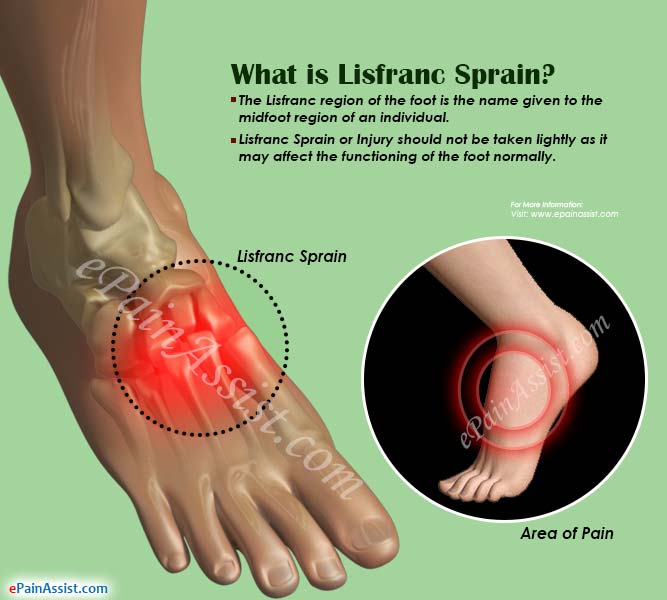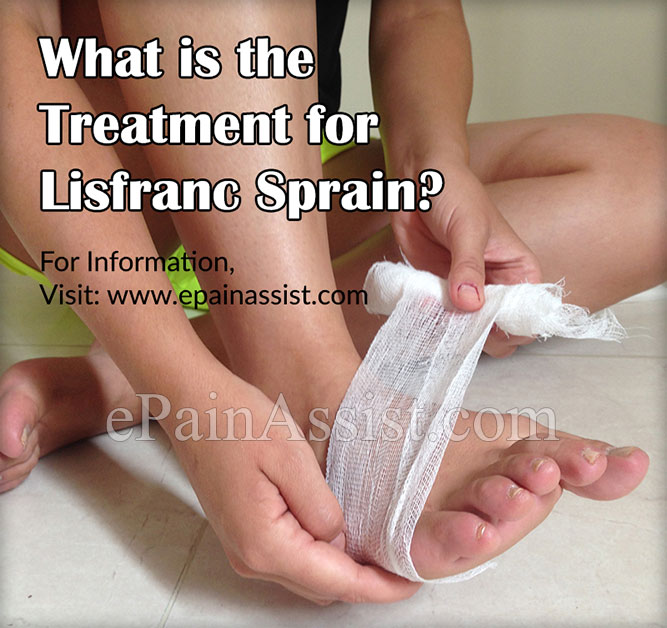What is Lisfranc Sprain?
The Lisfranc region of the foot is the name given to the midfoot region of an individual. This region contains many small bones which form the arch of the foot. Every bone in the Lisfranc region is very important and has a specialized role to play in giving stability and support to the foot. Hence a Lisfranc Sprain or Injury should not be taken lightly as it may affect the functioning of the foot normally.
In some cases if a Lisfranc sprain or injury is not treated appropriately then the damage caused by it may become permanent and the individual may not be able to have a normal foot ever again. When any of the bones or ligaments in the Lisfranc region gets torn or sprained then it is termed as Lisfranc Sprain. The major cause for a Lisfranc Sprain is sporting injury like when playing football or hockey where a player has to twist and turn very fast and also sometimes gets involved in a tackle which tends to pressurize the Lisfranc area resulting in Lisfranc Sprain.
Treatment for a Lisfranc Sprain is mainly conservative with adequate rest and avoiding activities that may aggravate the condition. It is important here to note that Lisfranc Sprain should not be taken lightly as most individuals do when they sprain their ankles or foot and in case if the pain and discomfort does not subside after a couple of days of sustaining the injury despite rest and medications then a consultation with a physician is a must to diagnose and start immediate treatment for Lisfranc Sprain.

What are the Causes of Lisfranc Sprain?
As stated, Lisfranc Sprain occurs mainly due to sporting injuries like football or hockey. Sometimes, Lisfranc Sprain can also occur due to a sudden twisting injury like a foot getting caught in a pothole resulting in tear of the ligaments of the midfoot or the Lisfranc region causing Lisfranc Sprain. Lisfranc Sprain can also occur if a heavy object falls on the midfoot region. Most of Lisfranc Sprains are taken as simple ankle sprain but the big difference between those two is the healing time. Where simple ankle sprains take less time to heal, a Lisfranc Sprain takes much longer time to heal or recover and if not taken care of appropriately may result in even some permanent damage to the midfoot.
What are the Symptoms of Lisfranc Sprain?
The classic presenting feature of Lisfranc Sprain is severe intense pain and swelling of the midfoot region. The individual will not be able to move the midfoot region and will find it extremely difficult to get up and ambulate immediately after the injury. The pain and difficulty with motion due to Lisfranc Sprain will not ease up even after rest for a couple of days. Some of the symptoms of Lisfranc Sprain are:
- Swelling with persistent pain on the top of the foot
- Bruising of the foot on the bottom of the arch area
- Sensitivity and pain with palpation of the midfoot area
- Any movement of the toe or foot will cause severe pain
- Difficulty with ambulation or standing for a period of time
- Abnormal widening of the foot.

How is Lisfranc Sprain Diagnosed?
In order to definitively diagnose Lisfranc Sprain, the physician will begin by conducting a detailed physical examination of the injured area. The physician will look are areas of swelling and tenderness. The physician will also try to move the toe and ankle region to check for any pain with movement of the joints. The physician will them ask the patient to bear weight on the affected extremity which in cases of Lisfranc Sprain the patient will not be able to do. In order to differentiate between a simple ankle sprain and a lisfranc sprain the physician will try to move the foot downwards which in cases of Lisfranc Sprain will cause severe intense pain.
Radiological studies may be ordered in the form of an x-ray, CT scan or an MRI to take a better look at the internal structures of the midfoot area and to rule out any potentially serious injuries like a fracture. This will more or less confirmatively confirm the diagnosis of Lisfranc Sprain.

What is the Treatment for Lisfranc Sprain?
The front line treatment for Lisfranc Sprain is conservative. To begin with the physician will recommend following the RICE protocol which is rest, ice, compression, and elevation. The patient will be recommended to avoid any activities that may aggravate the lisfranc sprain. The patient will also be recommended to not bear any sort of weight on the injured foot.
The patient will also be given pain medication and NSAIDs in the form of Tylenol and ibuprofen to calm down the pain and inflammation associated with Lisfranc Sprain. The foot may also be placed into a splint for immobilization to allow the lisfranc sprain or injury to heal and to prevent any aggravation of the injury. This will be done for a period of approximately a month before you will be allowed to gradually weight bear on the extremity as comfort allows. Once you are able to put some weight on the affected foot without any pain or discomfort then the splint will be removed and the patient will be placed in a boot. Once you have completely healed from the lisfranc injury or sprain you will be given supportive footwear to support the arches of the midfoot and prevent any recurrence of Lisfranc Sprain.
What is the Healing Time for Lisfranc Sprain?
The prognosis for Lisfranc Sprain is good if it is treated appropriately and the patient follows the recommendations of the physician diligently; otherwise, if the sprain does not heal completely it may lead to some permanent damage to the ligaments and cartilage which may require aggressive treatment in the future which may even include surgery. Hence it is recommended to follow the recommendations of the physician faithfully to successfully heal and return back to normal activities after sustaining a Lisfranc Sprain.
- OrthoInfo. (2020). Lisfranc (Midfoot) Injury. https://orthoinfo.aaos.org/en/diseases–conditions/lisfranc-midfoot-injury
- University of Rochester Medical Center. (n.d.). Lisfranc Injury. https://www.urmc.rochester.edu/encyclopedia/content.aspx?contenttypeid=85&contentid=p00915
Also Read:
